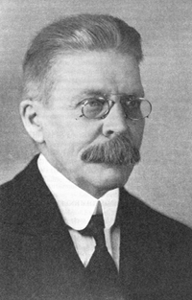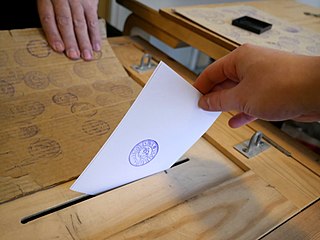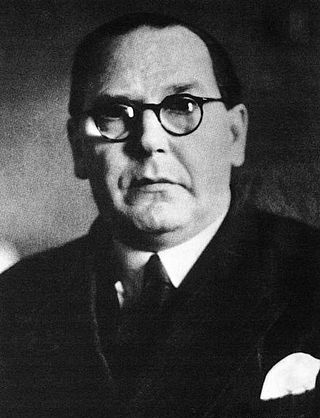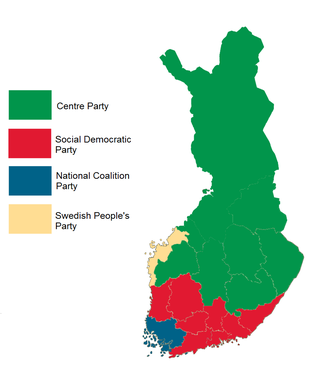
Urho Kaleva Kekkonen, often referred to by his initials UKK, was a Finnish politician who served as the eighth and longest-serving president of Finland from 1956 to 1982. He also served as prime minister, and held various other cabinet positions. He was the third and most recent president from the Agrarian League/Centre Party. Head of state for nearly 26 years, he dominated Finnish politics for 31 years overall. Holding a large amount of power, he won his later elections with little opposition and has often been classified as an autocrat.
In politics, a red–green alliance or red–green coalition is an alliance of "red" parties with "green" parties. The alliance is often based on common left political views, especially a shared distrust of corporate or capitalist institutions. While the "red" social-democratic parties tend to focus on the effects of capitalism on the working class, the "green" environmentalist parties tend to focus on the environmental effects of capitalism.

Aimo Kaarlo Cajander was the Prime Minister of Finland up to the Winter War.
The National Coalition Party is a liberal-conservative political party in Finland.

The Centre Party, officially the Centre Party of Finland, is an agrarian-centrist political party in Finland. Ideologically, the Centre Party is positioned in the centre on the political spectrum. It has been described as liberal, social-liberal, liberal-conservative, and conservative-liberal. The party’s leader is Annika Saarikko, who was elected in September 2020 to follow Katri Kulmuni, the former finance minister of Finland. As of December 2019, the party has been a coalition partner in the Marin Cabinet, led by Prime Minister Sanna Marin of the Social Democratic Party (SDP).

The Centre Party, formerly the Farmer's Party, is an agrarian political party in Norway.

There are four types of elections in Finland. Each Finnish citizen at least 18 years of age has the right to vote in each of the elections, which decide the following: the president, the parliament, the MEPs, and the municipal and city councils.
A minister without portfolio is a government minister without specific responsibility as head of a government department. The sinecure is particularly common in countries ruled by coalition governments and a cabinet with decision-making authority wherein ministers without portfolio, while they may not head any particular offices or ministries, may still receive a ministerial salary and have the right to cast a vote in cabinet decisions. The office may also exist to give party leaders whose offices would not otherwise enable them to sit in Cabinet.

Karl-August Fagerholm was a Finnish politician. Fagerholm served as Speaker of Parliament and three times Prime Minister of Finland. Fagerholm became one of the leading politicians of the Social Democrats after the armistice in the Continuation War. As a Scandinavia-oriented Swedish-speaking Finn, he was believed to be more to the taste of the Soviet Union's leadership than his predecessor, Väinö Tanner. Fagerholm's postwar career was, however, marked by fierce opposition from both the Soviet Union and the Communist Party of Finland. He narrowly lost the presidential election to Urho Kekkonen in 1956.

Parliamentary elections were held in Finland on 16 March 2003. The Centre Party led by Anneli Jäätteenmäki overtook the Social Democratic Party (SDP) to become the largest party in the Eduskunta. This was credited mainly to Jäätteenmäki's powerful leadership and modernization of the party still often viewed as agrarian and conservative by many. However, the SDP actually won some seats and increased its share of the vote, losing in the number of total popular votes only by a few thousand.
Parliamentary elections were held in Finland on 6 and 7 July 1958. The communist Finnish People's Democratic League emerged as the largest party, but was unable to form a government.
Parliamentary elections were held in Finland on 1 and 2 July 1936. Following the election Prime Minister Toivo Mikael Kivimäki of the National Progressive Party was defeated in a confidence vote in September 1936 and resigned in October. Kyösti Kallio of the Agrarian League formed a centrist minority government after Pehr Evind Svinhufvud refused to allow the Social Democrats to join the government. After Svinhufvud's defeat in the February 1937 presidential election, Kallio took office as the new President in March 1937, and he allowed the Social Democrats, Agrarians and Progressives to form the first centre-left or "red soil" Finnish government. Aimo Cajander (Progressive) became Prime Minister, although the real strong men of the government were Finance Minister Väinö Tanner and Defence Minister Juho Niukkanen (Agrarian).
Lauri Ingman's second cabinet was the 11th Government of independent Finland, serving between 31 May 1924 – 31 March 1925. It was formed following the 1924 parliamentary elections between four parties—National Coalition Party, Agrarian Party, National Progressive Party and Swedish People's Party—and had a majority in the parliament during the first six months. Overall, the cabinet lasted 305 days in office.

Kyösti Kallio's second cabinet was the 13th government of Finland from December 31, 1925 to December 13, 1926. It was formed between Agrarian Party and National Coalition Party, and had six ministers from each party. The cabinet lasted 348 days in office.

Kekkonen's second cabinet was the 34th government of Finland, which existed from 17 January 1951 to 20 September 1951. It was a majority government, and its Prime Minister was Urho Kekkonen.

Karl-August Fagerholm's third cabinet, also known as the Night Frost Cabinet or the Night Frost Government, was the 44th government of Republic of Finland, in office from August 29, 1958 to January 13, 1959. It was a majority government. The cabinet was formed after the parliamentary election of 1958.

The Finnish Rural Party was an agrarian and populist political party in Finland. Starting as a breakaway faction of the Agrarian League in 1959 as the Small Peasants' Party of Finland, the party was identified with the person of Veikko Vennamo, a former Agrarian League Member of Parliament known for his opposition to the politics of President Urho Kekkonen. Vennamo was chairman of the Finnish Rural Party between 1959 and 1979.

The Social Democratic Party of Finland is a social democratic and pro-European political party in Finland. It is the third largest party in the Parliament of Finland with 43 seats. Founded in 1899 as the Workers' Party of Finland, the SDP is Finland's oldest active political party and has a close relationship with the Central Organisation of Finnish Trade Unions. It is also a member of the Party of European Socialists, Progressive Alliance, Socialist International and SAMAK.














